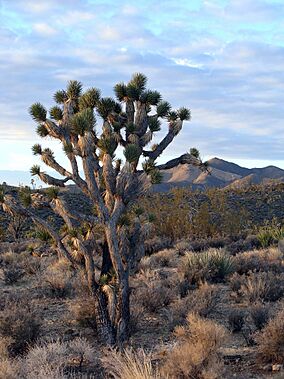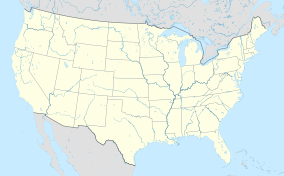Wee Thump Joshua Tree Wilderness facts for kids
Quick facts for kids Wee Thump Joshua Tree Wilderness |
|
|---|---|
|
IUCN Category Ib (Wilderness Area)
|
|
 |
|
| Location | Clark County, Nevada, U.S. |
| Nearest town | Searchlight, Nevada |
| Area | 6,489 acres (26 km2) |
| Established | 2002 |
| Governing body | U.S. Department of Interior, Bureau of Land Management |
The Wee Thump Joshua Tree Wilderness is a special protected area in Nevada, USA. It was created in 2002 to keep a large forest of old Joshua trees safe. This wilderness covers about 6,050 acres, which is like protecting over 4,500 football fields! The name "Wee Thump" comes from the Paiute people, and it means "ancient ones." This name fits perfectly because the wilderness protects very old Joshua trees.
The Wee Thump Joshua Tree Wilderness is managed by the Bureau of Land Management. It is located a few miles west of a town called Searchlight, Nevada. In 2023, this wilderness became part of a bigger protected area called Avi Kwa Ame National Monument.
Contents
What is a Wilderness Area?
A wilderness area is a special place where nature is protected. It is kept as wild as possible, with very few signs of humans. This means no roads, buildings, or machines are allowed. The goal is to let nature thrive without much interference.
Why Protect Wilderness?
Wilderness areas are important for many reasons. They protect plants and animals that need wild spaces to live. They also offer places for people to enjoy nature, like hiking or watching wildlife. Protecting these areas helps keep our planet healthy for everyone.
Discovering the Joshua Tree
The Joshua tree is a unique plant that grows in the deserts of the southwestern United States. It is not a true tree, but a type of yucca plant. These plants can live for hundreds of years, and some in Wee Thump are very old.
How Joshua Trees Grow
Joshua trees grow slowly, often just a few inches each year. They have spiky leaves and branches that twist and turn. In the spring, they grow beautiful white or yellow flowers. These flowers are pollinated by a special moth called the yucca moth.
Life Cycle of the Joshua Tree
The Joshua tree's life cycle is closely linked to the yucca moth. The moth lays its eggs in the tree's flowers and helps move pollen between flowers. This helps the tree make seeds. The seeds then fall to the ground and can grow into new Joshua trees. This partnership is very important for both the tree and the moth.
Animals of Wee Thump
Even though the desert can seem empty, many animals live in the Wee Thump Joshua Tree Wilderness. These animals have special ways to survive in the hot, dry environment.
Desert Wildlife
You might see different kinds of birds, like roadrunners or quail. Small mammals, such as jackrabbits, kangaroo rats, and coyotes, also call this wilderness home. Sometimes, you might even spot a desert tortoise, which is a protected species.
Visiting Wee Thump Wilderness
The Wee Thump Joshua Tree Wilderness is a great place to explore nature. Since it is a wilderness area, there are no paved roads or visitor centers. You can hike and enjoy the quiet beauty of the desert.
How to Explore Safely
When visiting, it is important to be prepared. Bring plenty of water, wear sunscreen, and tell someone where you are going. Always remember to "Leave No Trace." This means taking all your trash with you and not disturbing any plants or animals. By following these rules, you help keep the wilderness special for everyone.


